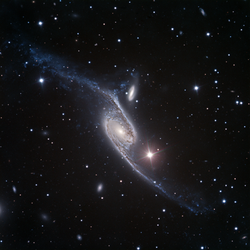NGC 6872
| Galaxie NGC 6872 | |
|---|---|
 | |
| Die Galaxien NGC 6872 (Mitte) und IC 4970 (oben), aufgenommen vom VLT | |
| AladinLite | |
| Sternbild | Pfau |
| Position Äquinoktium: J2000.0, Epoche: J2000.0 | |
| Rektaszension | 20h 16m 56,5s [1] |
| Deklination | −70° 46′ 05″ [1] |
| Erscheinungsbild | |
| Morphologischer Typ | SB(s)b / pec[1] |
| Helligkeit (visuell) | 11,7 mag[2] |
| Helligkeit (B-Band) | 12,5 mag[2] |
| Winkelausdehnung | 6′ × 1,5′[2] |
| Positionswinkel | 66°[2] |
| Flächenhelligkeit | 13,9 mag/arcmin²[2] |
| Physikalische Daten | |
| Zugehörigkeit | LDCE 1386[1] |
| Rotverschiebung | 0,016071 ± 0,000087[1] |
| Radialgeschwindigkeit | (4818 ± 26) km/s[1] |
| Hubbledistanz H0 = 73 km/(s • Mpc) | (210 ± 15) · 106 Lj (64,5 ± 4,5) Mpc [1] |
| Durchmesser | 350.000 Lj[3] |
| Geschichte | |
| Entdeckung | John Herschel |
| Entdeckungsdatum | 27. Juni 1835 |
| Katalogbezeichnungen | |
| NGC 6872 • PGC 64413 • ESO 073-032 • IRAS 20115-7055 • 2MASX J20165648-7046057 • AM 2011-705 • VV 297a • GC 4549 • h 3816 • | |
NGC 6872 (auch als Kondor-Galaxie, engl. Condor Galaxy bekannt) ist eine Balken-Spiralgalaxie vom Hubble-Typ SBb/P im Sternbild Pfau am Südsternhimmel. Sie ist schätzungsweise 210 Millionen Lichtjahre von der Milchstraße entfernt und hat einen Durchmesser von etwa 366.000 Lichtjahren. Sie ist damit eine der bislang größten entdeckten Spiralgalaxien. Das System steht in Wechselwirkung mit der kleinen Galaxie IC 4970, die oberhalb von NGC 6872 zu sehen ist.[4]
Im selben Himmelsareal befinden sich u. a. die Galaxien NGC 6876, IC 4967, IC 4971, IC 4972.
Das Objekt wurde am 27. Juni 1835 vom britischen Astronomen John Herschel entdeckt.[5]
- Hochaufgelöste Aufnahme mithilfe des Hubble-Weltraumteleskops
Literatur
- König, Michael & Binnewies, Stefan (2019): Bildatlas der Galaxien: Die Astrophysik hinter den Astrofotografien, Stuttgart: Kosmos, S. 399
Weblinks
- SIMBAD Astronomical Database
- ESO: Giant interacting galaxies NGC 6872/IC 4970
- Chandra
- Capella Observatorium
- An interacting colossus (engl.)
- CDS Portal
Einzelnachweise
Auf dieser Seite verwendete Medien
Autor/Urheber: Hubble ESA, Lizenz: CC BY 2.0
This picture, taken by the NASA/ESA Hubble Space Telescope’s Wide Field Planetary Camera 2 (WFPC2), shows a galaxy known as NGC 6872 in the constellation of Pavo (The Peacock). Its unusual shape is caused by its interactions with the smaller galaxy that can be seen just above NGC 6872, called IC 4970. They both lie roughly 300 million light-years away from Earth.
More information: <a href="http://www.spacetelescope.org/images/potw1437a/" rel="nofollow">www.spacetelescope.org/images/potw1437a/</a>
Credit: Image credit: ESA/Hubble & NASA
Acknowledgement: Judy Schmidt (geckzilla.com)Autor/Urheber: ESO/VLT, Judy Schmidt, Lizenz: CC BY 4.0
Something a little different. Instead of Hubble, this came from ESO. Specifically, from Paranal's FORS1 instrument. In 2010, ESO ran a Hidden Treasures contest just like the Hubble contest. First prize was a trip to Paranal. What!? I'm sorry I missed the contest completely! Anyway, this same galaxy (same data, too) has been featured on their site before so it isn't a hidden treasure itself, but it's been in the news lately.
Not knowing how to use ESO's public archive but wanting to learn, I ended up searching for this galaxy. The first rule of ESO's archive is there are no thumbnails. You just kind of guess what's there based on the coordinates and the exposure time, download the files en masse, and then browse their content on your own computer. You don't even get footprints! There is an xml file which you can open with Aladin which will plot a few dots for you, presumably at the coordinates the telescope was aimed at. Being a complete newbie, just seeing coordinates was not very helpful. I'm unfamiliar with the instruments so I don't know how much area they typically cover. I'm also a visual person if that wasn't obvious enough so working from just numbers takes extra effort.
Once I got the data sorted out, processing it is about the same as dealing with Hubble's. You have to clean up little black spots and things which look like hairs and dust. Each quarter of the image must be adjusted to match one another. Brighter stars bleed. Interestingly, the diffraction pattern (the colorful spikes seen around bright stars) is a bit different from what I've come to expect.
Wideband red, green, and blue filters were used to compose the image.
Red: R Band, VLT / FORS1 Green: V Band, VLT / FORS1 Blue: B Band, VLT / FORS1
North is NOT up. It is 20° clockwise from up.

